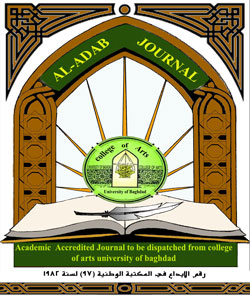Pragmatisches Denotat der Ausrufeformen im Vergleich
Deutsch-Arabisch Eine kontrastive Untersuchung
DOI:
https://doi.org/10.31973/aj.v0i133.678Keywords:
linguistics - pragmatics - exclamation - comparison - German – ArabicAbstract
This paper studies the pragmatic meanings of exclamation in both the German and Arabic languages. It is considered an attempt to know all the different pragmatic aspects of the sentence that carries the exclamatory meaning in both languages. It also addresses the multiple grammatical forms of exclamation in both languages. The research seeks to identify similar grammatical structures of the exclamatory sentences in an attempt to reach a clear possibility to translate the style of the different types of sentences under study by analyzing their pragmatic meaning in order to overcome the difficulties that face the translator and the possibility of separating them from the rest of the types of sentences as they overlap with the different types of sentences.
Downloads
References
Abdulḥamīd, M. M.-D. (kein Datum). Šarḥ Qatr ʿAl- Nada Wabal ʿAl- ṣadā/ taṣnīf Abū Muḥammad ʿAbdallāh Jamāl ad-Dīn Wamahu Qitab Sabīl ʿAl- Huda.
Assāmārrāī, F. S. (2003). Maānī n-naḥw Bd. 4. Kairo.
Aš-Šukrī, M. A. (2011). al-ẓawāhir al-islūbīa. Babil: Babil Uni.
Autorenkollektiv. (1984). Grundzüge einer deutschen Grammatik. Berlin.
Avis, F. J. (2001). Über w- Exklamativsätze im Deutschen. Tübingen.
ʿAzūz, Ḥ. b. (kein Datum). Funktionale Dimension des Tonens bei der Bestimmung der Art der sprachlichen Methoden. Algerien: revues.univ.-biskara.dz/index.php/fll/article/download/793/747.
Balcik, I., & Röhe, K. (2010). Deutsche Grammatik und Rechtschreibung. Stuttgart.
Bußmann, H. (2002). Lexikon der Sprachwissenschaft. Stuttgart.
Eisenberg, P. e. ( 1998). Duden 4, Grammatik der deutschen Gegenwartssprache, 6. Auflage, Bibliographisches. Mannheim / Wien / Leipzig / Zürich: Dudenverlag.
Erben, J. (1967). Abriss der deutschen Grammatik. Berlin.
Finkbeiner, R. (2015). Wie deutsch ist DAS denn? oder Konstruktion? Sendbote zwischen den Kulturen/ Gustav Korlén und die germanistische Tradition an der Universität Stockholm, 243-273.
Fleicher W., e. a. (2001). Kleine Enzyklopädie/ Deutsche Sprache. Peter Lang europäischer Verlag der Wissenschaft.
Fries. (1994). Grammatik, Emotionen und Äußerungsbedeutung. Sprache und Pragmatik Arbeitsbeichte , 1-37.
Fries, N. (1988). Ist Pragmatik schwer! - Über sogenannte Exklamativsätze im Deutschen. Sprache und Pragmatik Arbeitsberichte , 1- 49.
Fries, N. (1991). Emotionen. Experimentalwissenschaflische und konzeptuelle Aspekte. Sprache und Pragmatik Arbeitsberichte, 1-18.
Ḥasān, A. (1975). An-naḥw al-wāfī. Ägypten.
Helbig, G. (1994). Lexikon deutscher Partikeln. Leipzig.
Helbig, G., & Buscha, J. (2001). Deutsche Grammatik; Ein Handbuch für den Ausländerunterrich. München.
Hentschel, E. (2010 ). Deutsche Grammatik. Berlin, New York: Walter de Gruyter GmbH & Co. KG.
Hentschel, E., & Weydt, H. (2003). Handbuch der deutschen Grammatik. Berlin.
Hoffmann, M. (2003). Der Koran; Das heilige Buch des Islam. Istanbul.
Näf, A. (1996). Die w-Exklamativsätze im Deutschen - zugleich ein Plädoyer für eine Rehabilitierung der Empirie in der Sprachwissenschaft. ZGL 24, 135-152.
Niʿma, F. (kein Datum). Mulaḫas Qawaʿid Alluġa Alʿarabīya.
Reis, M. (2000). Anmerkungen zu Verb-erst- Satz-Typen im Deutschen. Reis, Marga 2000: Anmerkungen zu VerGrammatik in Theorie und Praxis.Thieroff R., Tamrat M.,Fuhrhop N.,Teuber O., Tübingen.
Rinas, K. (2010). Partikeln als semantische Mumien: Zur Bedeutung von wohl, vielleicht und snad in Ausrufesätzen. Studia Germanistika, Číslo 6, Acta Fakultatis Philosophicae , Universitatis Ostraviensis, Ostrava, 113-128.
Rosengren, I. (1992). Zur Grammatik und Pragmatik der Ausrufe. Satz und Illokution. Bd. 1.Rosengren I, Tübungen, 263-306.
Schulz, E. (2004). Modernes Hocharabisch Grammatik. Wiesbaden.
Thurmair, M. (1989). Modalpartikeln und ihre Kombinationen. Tübingen: Niemeyer .
Vankova, L. (2010). zur Kategorie der Emotionalität. Am Beispiel der figurenrede Studia Germanistika. Ostrava: Universitatis Ostraviensis.
Zifonun, G., Hoffmann, L., & Strecker, B. (1997). Grammatik der deutschen Sprache Band 1. Berlin: Walter de Gruyter.
Downloads
Published
Issue
Section
License
Copyright and Licensing:
For all articles published in Al-Adab journal, copyright is retained by the authors. Articles are licensed under an open access Creative Commons CC BY 4.0 license, meaning that anyone may download and read the paper for free. In addition, the article may be reused and quoted provided that the original published version is cited. These conditions allow for maximum use and exposure of the work.
Reproducing Published Material from other Publishers: It is absolutely essential that authors obtain permission to reproduce any published material (figures, schemes, tables or any extract of a text) which does not fall into the public domain, or for which they do not hold the copyright. Permission should be requested by the authors from the copyrightholder (usually the Publisher, please refer to the imprint of the individual publications to identify the copyrightholder).
Permission is required for: Your own works published by other Publishers and for which you did not retain copyright.
Substantial extracts from anyones' works or a series of works.
Use of Tables, Graphs, Charts, Schemes and Artworks if they are unaltered or slightly modified.
Photographs for which you do not hold copyright.
Permission is not required for: Reconstruction of your own table with data already published elsewhere. Please notice that in this case you must cite the source of the data in the form of either "Data from..." or "Adapted from...".
Reasonably short quotes are considered fair use and therefore do not require permission.
Graphs, Charts, Schemes and Artworks that are completely redrawn by the authors and significantly changed beyond recognition do not require permission.
Obtaining Permission
In order to avoid unnecessary delays in the publication process, you should start obtaining permissions as early as possible. If in any doubt about the copyright, apply for permission. Al-Adab Journal cannot publish material from other publications without permission.
The copyright holder may give you instructions on the form of acknowledgement to be followed; otherwise follow the style: "Reproduced with permission from [author], [book/journal title]; published by [publisher], [year].' at the end of the caption of the Table, Figure or Scheme.











